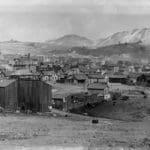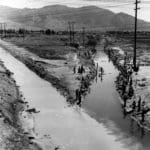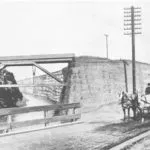In September 2021, Woodard & Curran registered the Silver Bow Creek Conservation Area (SBCCA) under the Institute for Sustainable Infrastructure’s Envision framework. This marks a first within Woodard & Curran, our client, and partners in pursuing Envision certification, a globally recognized, highly credible approach to sustainable, resilient, and equitable infrastructure for communities.
Sustainable Remediation
The SBCCA encompasses seven projects within the Butte Priority Soils Operable Unit of the Silver Bow Creek/Butte Area Superfund Site in Montana. Work has been underway since the 1980s to address contamination of soil, surface water, and groundwater resulting from historic copper mining, ore recovery, and processing in the region. Remediation activities include removal of contaminated mine waste, soils, and stream sediments; reconstruction of streams; capture and treatment of contaminated groundwater and stormwater; and replanting to stabilize soils and restore habitat.
- View of Butte looking NE ca. 1890 – Butte-Silver Bow Public Archives
- Convergence of Silver Bow and Blacktail Creeks – Butte-Silver Bow Public Archives
- Slag Walls Line the Banks of Silver Bow Creek, 1914 – USGS
Historic images provided to Woodard & Curran by Land Design Inc.
The end land use of the project includes a variety of amenities for public recreation, economic development, and biodiversity enhancement. The SBCCA plans to set aside 126 acres for connected greenways in Butte, including natural park spaces with reconstructed wetlands, flowing water, abundant native plants, wildlife habitat, play areas, plaza areas, gathering spaces, and interpretive features. Nearly eight miles of trails and boardwalks will allow all-season access to these areas. Straddling residential, commercial, and industrial zones, the project area provides a physical and visual connection between historic Uptown Butte and the newer development on the Butte flats.
A Net-Positive Impact
The Envision framework is a natural fit for the SBCCA project, allowing our client to ensure accountability in sustainable decision making, demonstrate the project is serving the local community, and highlight the work being conducted at the SBCCA beyond the required remedy. This project includes many features that are not required by the EPA for remediation of the site, but will contribute greatly to the local community and environment.
Envision Framework Categories:
- Quality of Life: Wellbeing, Mobility, Community
- Leadership: Collaboration, Planning, Economy
- Resource Allocation: Materials, Energy, Water
- Natural World: Siting, Conservation, Ecology
- Climate and Resilience: Emissions, Resilience
The Envision framework addresses a project’s impact on its immediate surroundings as well as broader environmental impacts and resiliency. Like projects rated via SITES and LEED certification, Envision projects are rated by achievement levels from Bronze to Platinum. Now that the SBCCA is registered under the framework, Woodard & Curran and its partners are employing relevant sustainable practices, materials, and approaches in design and implementation to maximize the project’s certification level. In addition to Envision, SBCCA is pre-certified with SITES, remedial activities will adhere to EPA’s Principles for Greener Cleanups, and the client is planning to pursue Wildlife Habitat Council certification.
Nature-Based Solutions
Envision aligns closely with our client’s ESG priorities, particularly a focus on enhancing biodiversity on new project sites. Striving to achieve a net-positive impact, metrics outlined in this framework allow our team and our client to implement restoration components that emphasize habitat creation and protection.
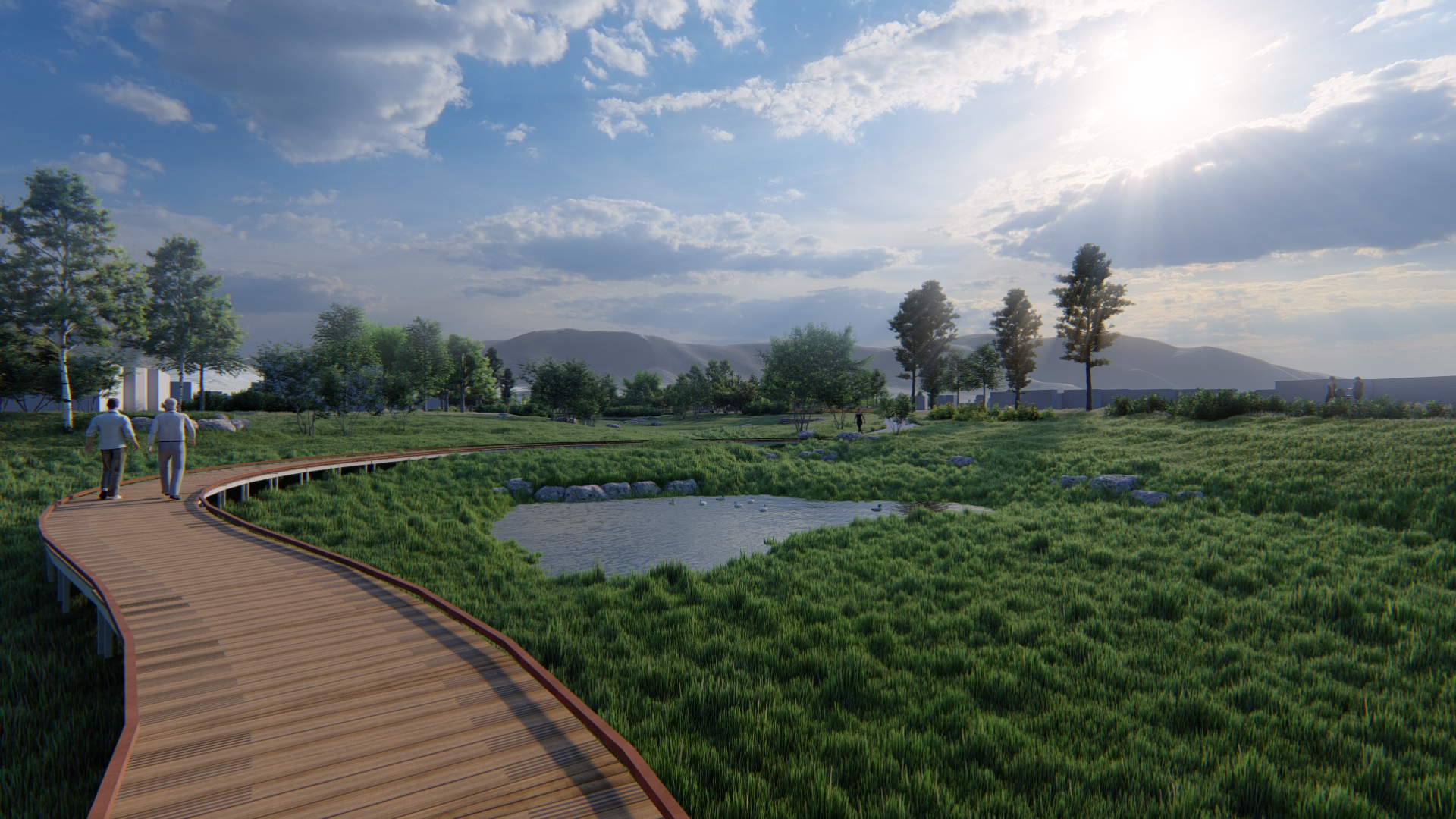
Boardwalk rendering by Land Design Inc.
We’ve incorporated numerous nature-based solutions into remedy design that serve the dual purpose of site cleanup and enhancing biodiversity. For example, stormwater ponds with wetlands and vegetated swales will treat impacted stormwater runoff and provide habitat for native species. These elements provide greater value than a combination of standalone remediation and sustainability measures.
Quantifying Investments in Sustainability
The project team developed four incremental value scenarios to quantify ecological and social impacts in relation to varying levels of remediation and expense. Any single level or combination of biodiversity treatments could be applied to a project site based on objectives and existing site conditions and in alignment with our client’s ESG goals. These value scenarios empowered our client to maximize cost-benefit and select remediation and restoration activities with significant positive environmental and community impacts while effectively managing financial obligations.
Level I – Basic Revegetation
Amendment of existing site soils and application of native seed mix including grasses, shrubs, forbs, and perennials. Includes installation of mulch and weed barrier where required. Meets minimum cleanup requirements.
Level II – Native Trees and Shrubs
Planting of native trees and shrubs of various caliper size and installation of edging, application of fertilizer. Enhance vegetation biodiversity to attract and increase wildlife habitat.
Level III – Riparian Development and Irrigation
Installation of irrigation systems to ensure sustainment of plantings, and construction of wetlands, streams, and riparian habitat. Broadens biodiversity from terrestrial to aquatic flora and fauna.
Level IV – Social and Community Benefit
Construction of trails and boardwalks and installation of decorative rock, park furnishings, site lighting, and interpretive signage. Benefits community health and quality of life with exposure to nature and enhanced habitats.
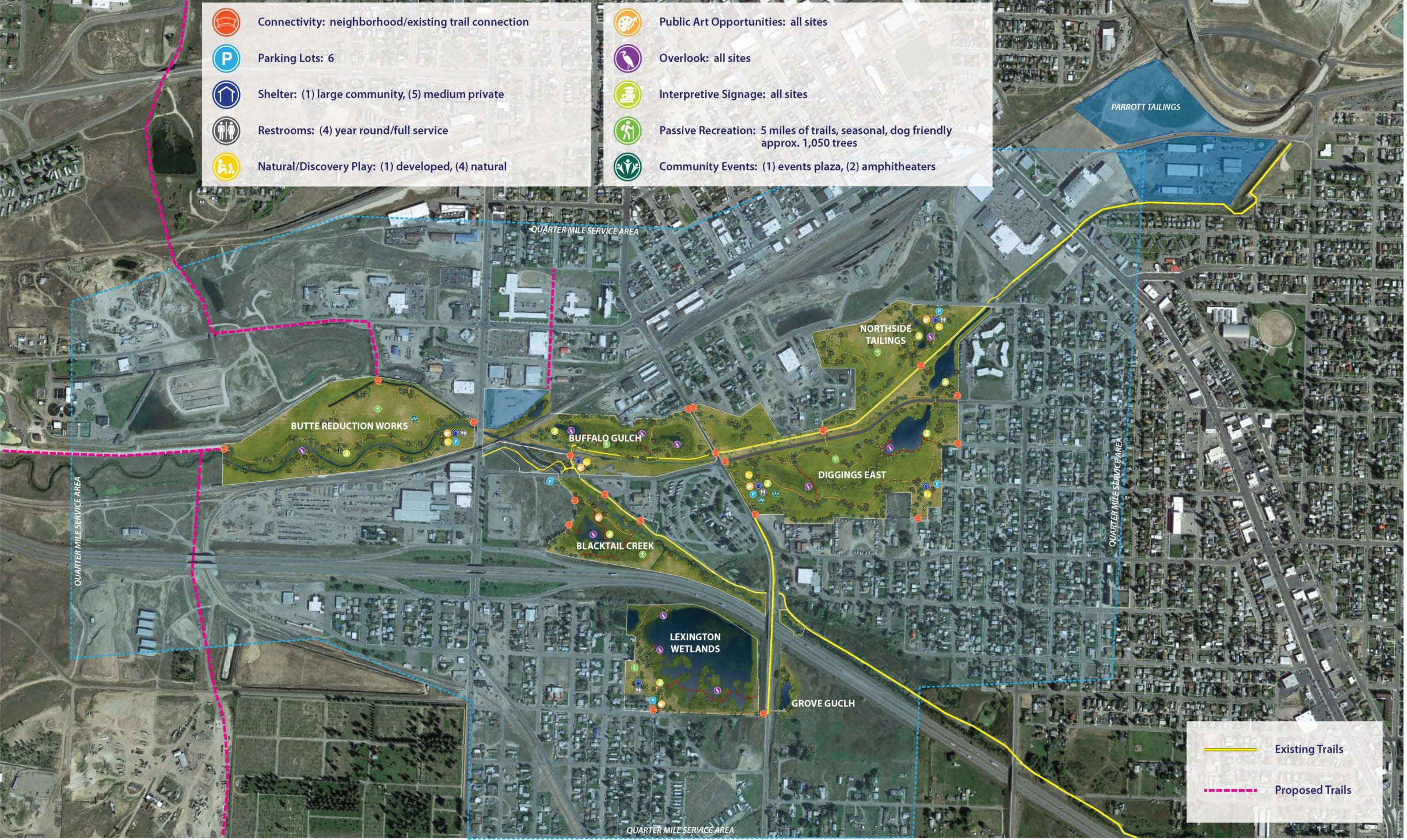
Public Programming Map by Land Design Inc.
The costs of each treatment level were determined for seven unique areas (totaling ~126 acres) within the SBCCA using the project’s existing engineering estimates. These costs have been averaged across the seven unique areas within the broader SBCCA and are presented below as a percentage of total cost per acre as a unit cost.
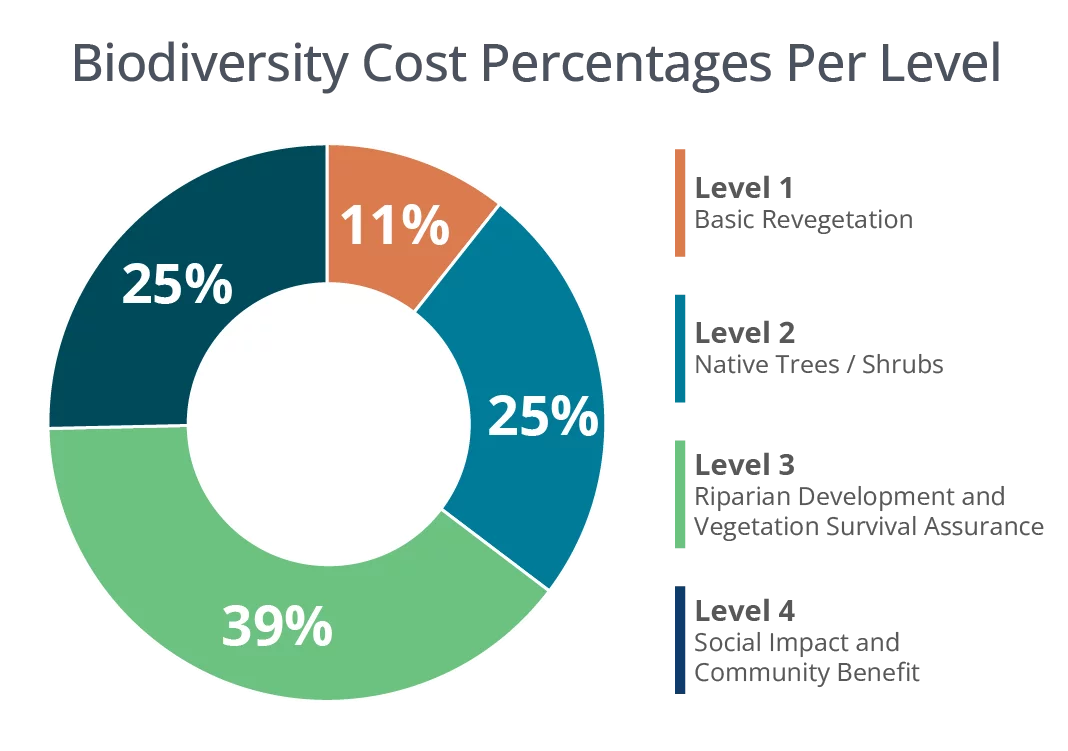
Optimizing Haul Routes for Social and Environmental Impacts
Remediating and restoring a site at the heart of a city creates highly visible community impact. Specifically, transporting 800,000 cubic yards of contaminated soils and mining waste from the project area to a repository outside of town inevitably impacts community members and the environment. To ensure this process equitably mitigates traffic and safety concerns, environmental impact, and cost, the project team conducted a haul route sustainability analysis on behalf of our client.
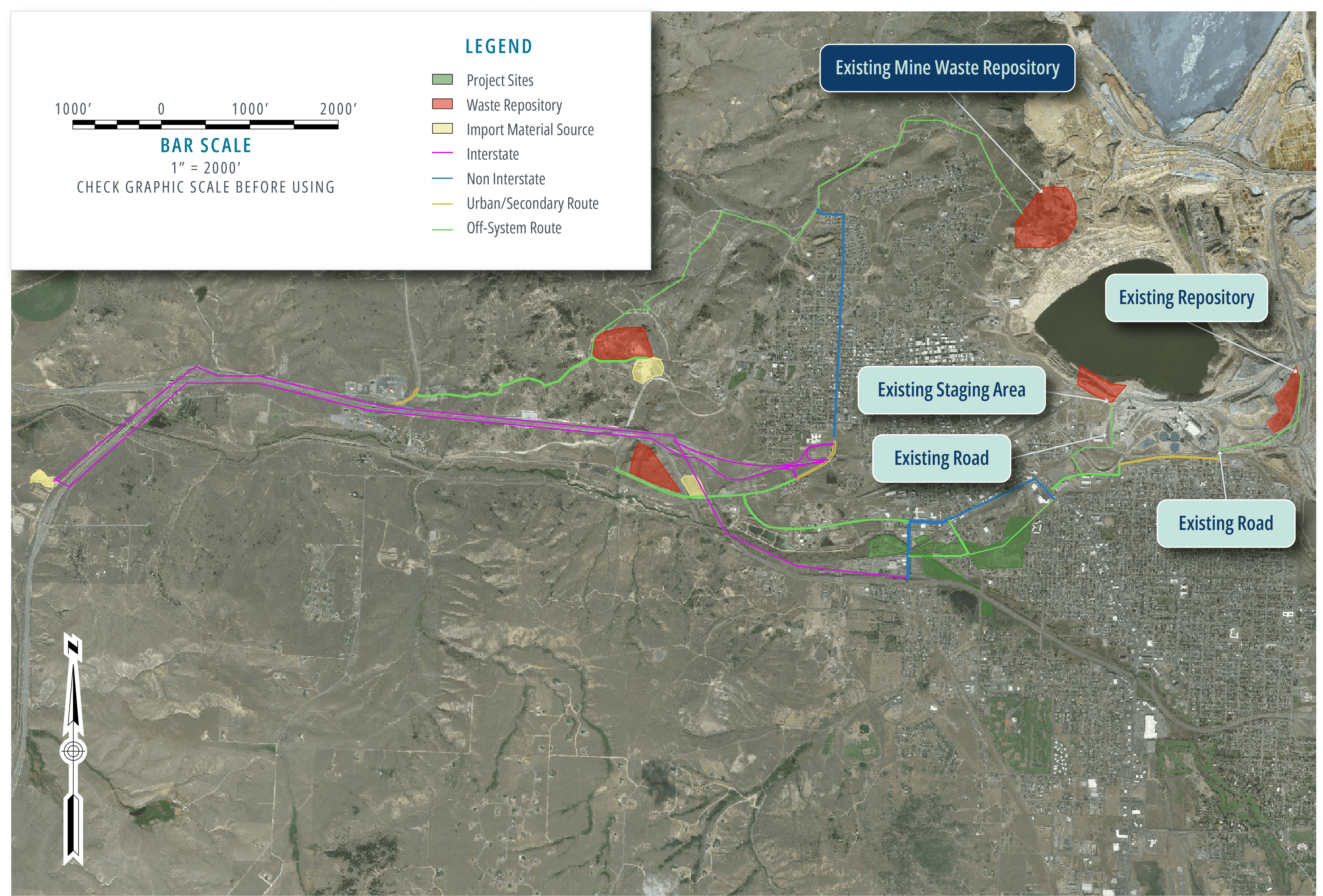
We analyzed 22 alternatives — all different combinations of transportation methods, routes, and destinations. Potential means of transportation included trucking, train and conveyor belt. Routes assessed prioritized short distances and avoidance of residential areas. The team identified five potential repositories, some already established in the footprint of the existing mine, others that would need to be constructed to serve the project. We assessed each alternative based on three major criteria, in order of importance: safety, environmental impact, and cost.
- Safety (weight x3)
- Safety incidents were estimated based on total mileage, local traffic studies, and national accident and fatality ratios
- Environmental impact (weight x2)
- Greenhouse gas emissions and hazardous air pollutant emissions were estimated using EPA Spreadsheets for Environmental Footprint Analysis (SEFA) modeling. SEFA modeling inputs included haul distance, projected waste volumes, on-site fuel consumption, estimated construction time, and construction of additional infrastructure
- Cost (weight x1)
- Costs evaluations were estimated using historical project data and RS Means to generate pre-improvement costs, hauling operational costs, and post construction improvement costs.
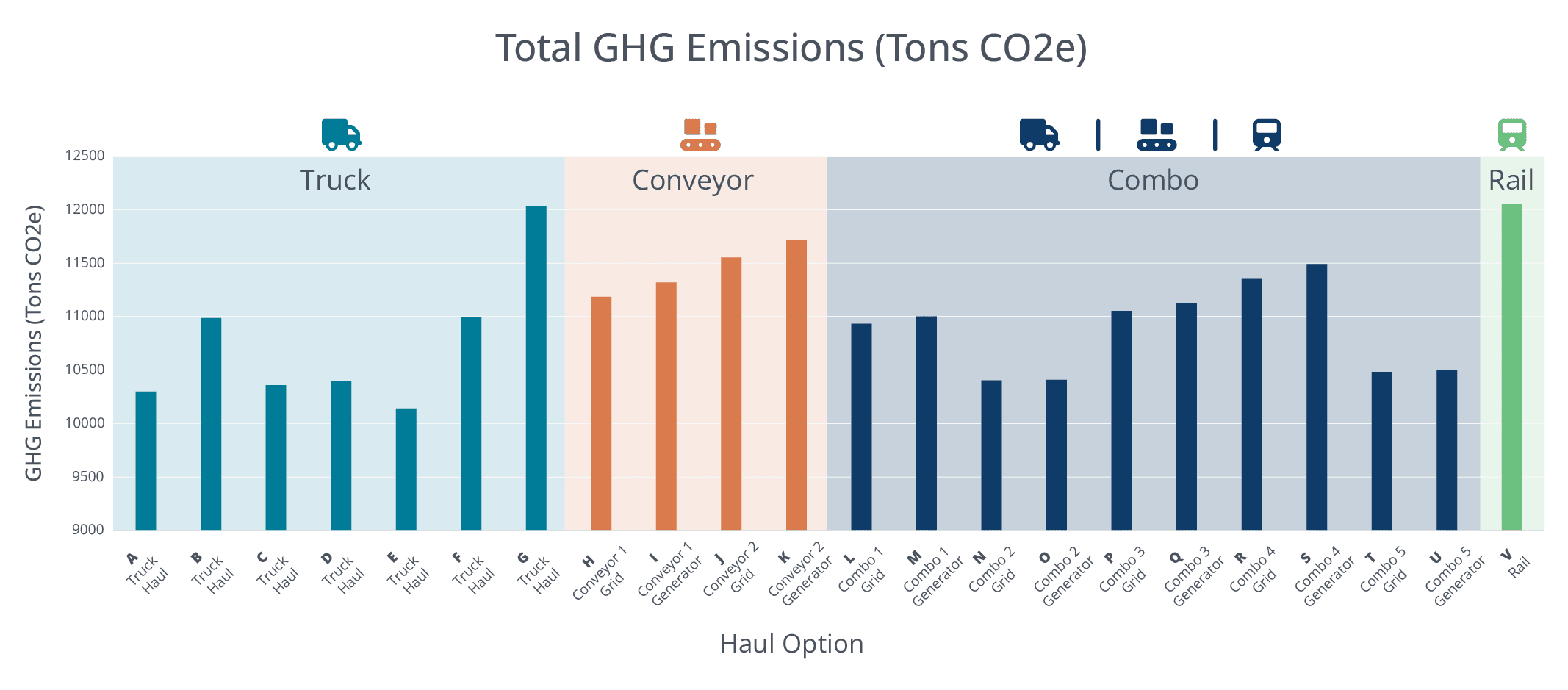
After ranking the route alternatives using a weighted formula, the team arrived at a preferred route, which will be under review with relevant agencies, followed by a public engagement process before construction. The proposed solution is a road route, sending loaded trucks 4 miles from the heart of the cleanup site to an existing repository at the edge of town. While the proposed route does not entirely avoid the need for infrastructure upgrades and roadway alterations, it effectively avoids residential areas, minimizes traffic disruption (an estimated traffic increase of just 1-2 percent) and incorporates only minor road construction and installation of a temporary crossing signal and pedestrian crossings for added safety where trucks exit the site.

Sustainability and impact reporting is a material issue and disclosure opportunity for many of our clients, particularly with the anticipation of new U.S. Securities and Exchange Commission requirements. We help our clients meet those regulatory obligations and advance their social and environmental stewardship goals by incorporating nature-based remedies, minimizing emissions, and engaging meaningfully with impacted communities throughout our sustainable remediation projects.
